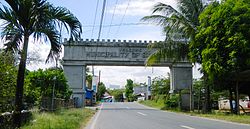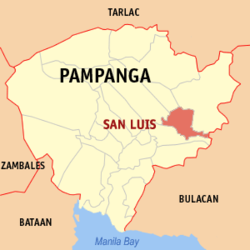San Luis, Pampanga
| San Luis | |||
|---|---|---|---|
| Municipality | |||
 |
|||
|
|||
 Map of Pampanga showing the location of San Luis |
|||
| Location within the Philippines | |||
| Coordinates: 15°2′24″N 120°47′31″E / 15.04000°N 120.79194°ECoordinates: 15°2′24″N 120°47′31″E / 15.04000°N 120.79194°E | |||
| Country | Philippines | ||
| Region | Central Luzon (Region III) | ||
| Province | Pampanga | ||
| District | 4th District | ||
| Founded | 1761 | ||
| Barangays | 17 | ||
| Government | |||
| • Mayor | Venancio Sagum-Macapagal | ||
| Area | |||
| • Total | 56.83 km2 (21.94 sq mi) | ||
| Population (2010) | |||
| • Total | 49,311 | ||
| • Density | 870/km2 (2,200/sq mi) | ||
| Time zone | PST (UTC+8) | ||
| ZIP code | 2014 | ||
| Dialing code | 45 | ||
| Income class | 3rd class | ||
San Luis is a third-class municipality in the province of Pampanga, Philippines. According to the 2010 census, it has a population of 49,311 people.
San Luis is politically subdivided into 17 barangays. Like the town itself, all political subdivisions are named after Roman Catholic saints.
Like other municipalities and cities in Pampanga, its people are mostly Kapampangan.
Roman Catholicism remains the faith of the majority in San Luis, although there are other denominations in the town, including:
others
The municipal government is divided into three branches: executive, legislative and judiciary. The judicial branch is administered solely by the Supreme Court of the Philippines. The executive branch is composed of the mayor and the barangay captains for the barangays. The legislative branch is composed of the Sangguniang Bayan (town assembly), Sangguniang Barangay (barangay council), and the Sangguniang Kabataan for the youth sector.
The current mayor of San Luis, Venancio "Asyong" Macapagal, and the vice mayor is Leonardo S. Salas Jr.
Transportation, trade and commerce in San Luis is concentrated at the town center where the public market, cockpit, municipal hall, church, schools, hospital, clinics, and commercial spaces are situated.
Its façade can compare immeasurably with existing Spanish-style church edifices and architectural design. The church is located in a place that used to be called Cabagsac, referring to the proliferation of fruit bats. In fact, today, a fishnet is permanently installed high above the altar precisely to catch thousands of bats that are roosting inside the church. The interior is dark, has an ambience of antiquity and mystery and overpowering odor of bat urine. The main attraction is the three-tower facade, perhaps one of its kind in the country. Not to be missed is the ancient cemetery located in a hidden corner at the back of the church, with some tombstones dating back to the 1800s and bearing the names of the town's prominent families, including Taruc.
...
Wikipedia



